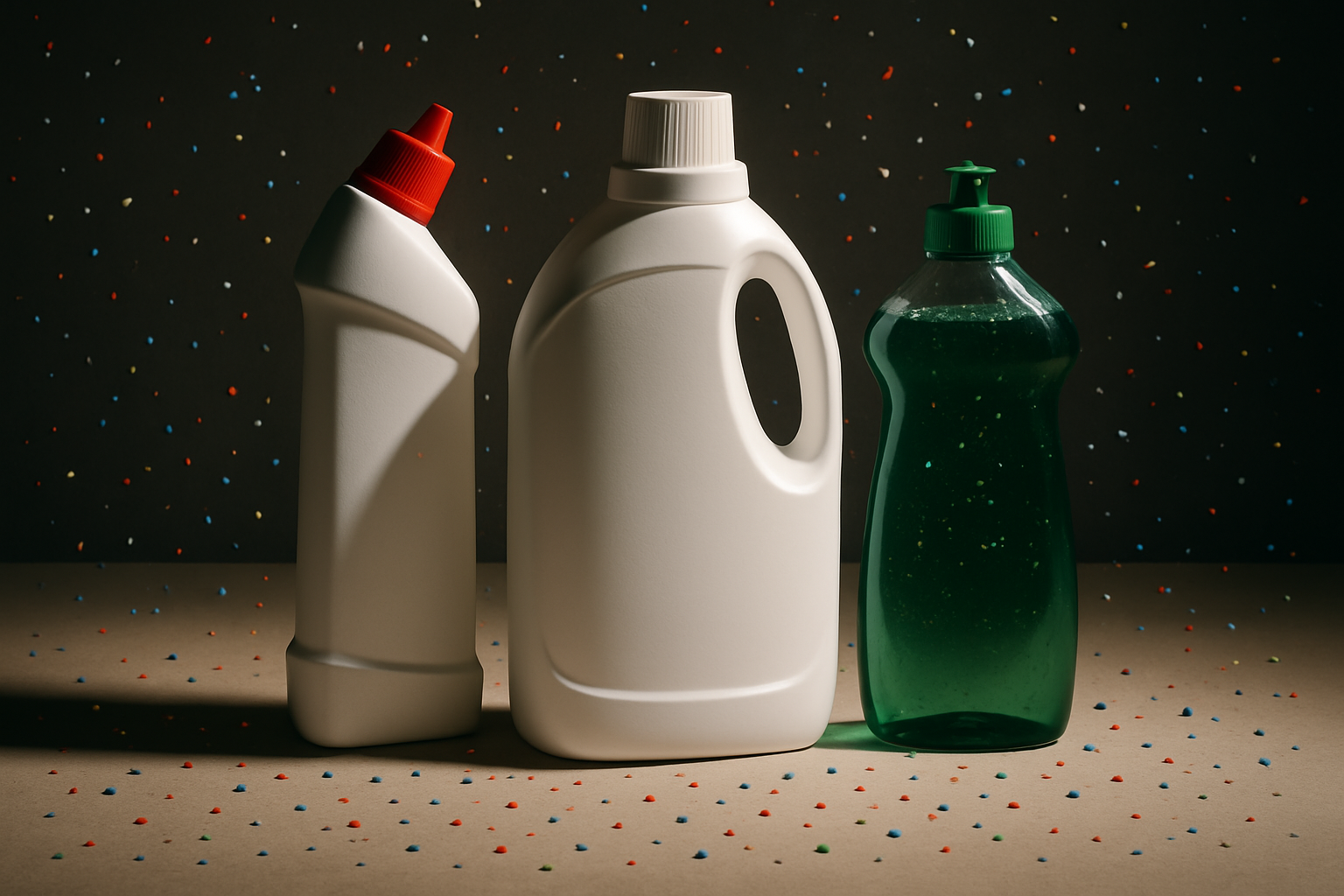
Cleaning Products Contamination: 40 Trillion Particles Released Annually
A groundbreaking study has revealed that household cleaning products release an estimated 40 trillion microplastic particles annually into the environment, making them one of the largest sources of intentional microplastic pollution. With 39.7% of detergents containing microplastics and average contamination levels of 564.97 particles per kilogram, our daily cleaning routines have become a major source of plastic pollution in our homes and waterways.
The Hidden Plastic in Household Cleaning
While consumers have become increasingly aware of microplastics in food and cosmetics, the contamination of household cleaning products has remained largely hidden from public view. Unlike other sources of microplastic contamination, cleaning products represent intentional addition of plastic particles to achieve specific cleaning properties and product performance.
This intentional use means that every time we wash dishes, do laundry, or clean our homes, we are deliberately releasing billions of plastic particles into our immediate environment and the broader ecosystem.
The Scale of Cleaning Product Contamination
Recent research analyzing household cleaning products has revealed contamination levels that dwarf many other sources:
- 564.97 particles per kilogram average contamination across all product types
- 40 trillion particles released globally from cleaning products annually
- 39.7% of detergents contain microplastics (119 of 300 products tested)
- Toilet bowl cleaners show the highest contamination levels
- 56.44% of total emissions come from toilet cleaning products alone
Product Category Analysis: Contamination Hotspots
Different categories of cleaning products show dramatically different levels of microplastic contamination, with some products posing significantly higher environmental and health risks than others.
Highest Risk Categories
Toilet Bowl Cleaners
Toilet bowl cleaners represent the most contaminated category of cleaning products, contributing over half of all microplastic emissions from household cleaners. Our database analysis shows concerning patterns across major brands in this category.
Laundry Detergents
With nearly 40% of detergents containing microplastics, laundry products represent a major source of contamination that enters wastewater systems with every wash cycle. Products like conventional liquid detergents show consistently higher contamination levels.
Dishwashing Products
Dishwashing liquids and detergents contribute significant microplastic contamination that comes into direct contact with our dishes and cookware. The contamination can transfer to food during the washing process.
Safer Cleaning Alternatives
Our comprehensive analysis of 610+ products reveals significant variations in contamination levels among cleaning products. Consumers can dramatically reduce their microplastic exposure by choosing safer alternatives.
Low-Contamination Cleaning Products
✅ Safer Choices
- Plant-based cleaning concentrates
- Powder detergents over liquid formulations
- Products with minimal packaging
- Certified organic cleaning products
- DIY cleaning solutions with simple ingredients
⚠️ Products to Avoid
- Toilet bowl cleaners with high contamination
- Liquid detergents with plastic additives
- Products with "microbeads" or "scrubbing particles"
- Heavily fragranced cleaning products
- Single-use cleaning wipes and pods
Environmental Impact: From Home to Ocean
The 40 trillion microplastic particles released annually from cleaning products don't simply disappear down the drain. They follow a contamination pathway that affects every level of our environment.
The Contamination Pathway
1. Household Release
Every cleaning session releases millions of particles into household wastewater, creating immediate exposure for family members and pets through inhalation and skin contact.
2. Wastewater Treatment
Municipal wastewater treatment plants cannot effectively filter microplastics, allowing billions of particles to pass through into rivers, lakes, and oceans.
3. Environmental Accumulation
Microplastics from cleaning products accumulate in marine ecosystems, entering the food chain and eventually returning to human consumption through seafood and drinking water.
Health Implications of Cleaning Product Contamination
Unlike microplastics from food packaging or cosmetics, cleaning product contamination creates unique exposure pathways that can affect health through multiple routes.
Exposure Routes
- Inhalation: Airborne particles released during cleaning activities
- Dermal contact: Direct skin exposure during cleaning tasks
- Ingestion: Residual contamination on dishes and surfaces
- Environmental exposure: Contaminated water and air in the home
Vulnerable Populations
Certain groups face higher risks from cleaning product microplastic contamination:
- Professional cleaners: Daily occupational exposure to high concentrations
- Children: Higher exposure relative to body weight and developing systems
- Pregnant women: Potential impacts on fetal development
- Individuals with respiratory conditions: Increased sensitivity to airborne particles
Consumer Protection Strategies
While regulatory action is needed to address the intentional addition of microplastics to cleaning products, consumers can take immediate steps to reduce their exposure.
Immediate Actions
Product Selection
- Choose powder detergents over liquid formulations
- Select products with minimal ingredient lists
- Avoid products advertising "scrubbing beads" or "microparticles"
- Use our product database to compare contamination levels
Usage Practices
- Ensure adequate ventilation during cleaning
- Wear gloves to reduce dermal exposure
- Use minimal amounts of cleaning products
- Rinse surfaces thoroughly after cleaning
DIY Cleaning Alternatives
Simple household ingredients can create effective cleaning solutions without microplastic contamination:
- White vinegar: Effective for glass, mirrors, and general cleaning
- Baking soda: Natural abrasive for scrubbing without plastic particles
- Castile soap: Plant-based alternative to synthetic detergents
- Lemon juice: Natural degreaser and disinfectant